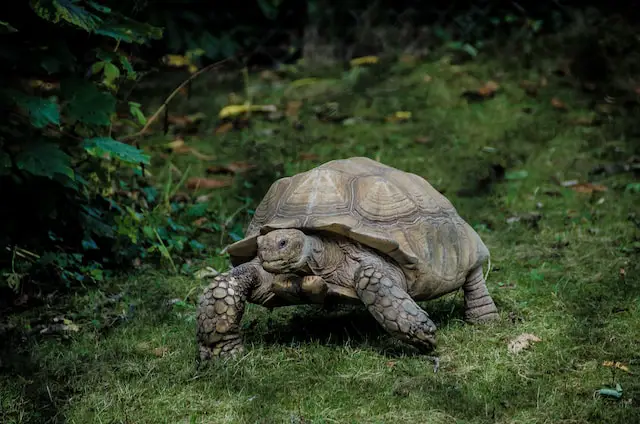Tortoises are fascinating creatures that have been around for millions of years. They are known for their hard, protective shells and slow, steady movements.
However, there is a common myth that tortoises can give you warts. This article will explore the truth behind this myth and provide accurate information about tortoises and their relationship to warts.
Many believe touching a tortoise can cause warts, but this is untrue.
Warts are caused by a virus called human papillomavirus (HPV), which is spread through skin-to-skin contact with an infected person.
Tortoises cannot transmit HPV to humans, so there is no need to worry about getting warts from these gentle creatures.
While tortoises cannot give you warts, practicing good hygiene when handling them is still essential.
This includes washing your hands before and after touching a tortoise and keeping their enclosure clean and free of bacteria.
By following these simple guidelines, you can enjoy the company of these fantastic animals without any fear of getting warts.
Tortoises and Warts
Tortoises are fascinating creatures that have been kept as pets for many years. One of the most common questions people ask considering getting a tortoise as a pet is whether or not they can give you warts.
The short answer is no; tortoises do not give you warts.
Warts are caused by a virus called human papillomavirus (HPV). This virus is only found in humans and cannot be transmitted from animals to humans. Therefore, there is no way that a tortoise can give you warts.
However, it is essential to note that tortoises can carry other types of bacteria and viruses that can harm humans.
For example, Salmonella is a common bacteria in many reptiles, including tortoises. Practicing good hygiene when handling tortoises or other reptiles is essential to avoid getting sick.
In conclusion, while tortoises do not give you warts, it is essential to be aware of the potential health risks associated with handling them.
Always wash your hands thoroughly after handling a tortoise, and avoid letting them roam freely in areas where food is prepared or consumed.
Warts and Viruses
Human Papillomavirus (HPV)
HPV is a common virus that can cause warts on the skin. There are many different types of HPV, and some can cause warts on the hands, feet, and other parts of the body.
However, the strains of HPV that cause warts in humans are not the same as those that infect tortoises. Therefore, a person can’t get warts from a tortoise.
Molluscum Contagiosum Virus (MCV)
MCV is another virus that can cause warts on the skin. Like HPV, it is not the same virus that infects tortoises.
MCV is most commonly spread through skin-to-skin contact and is more likely to affect children than adults.
While a person can contract MCV from contact with a tortoise, it is not shared.
It is important to note that viruses do not always cause warts. They can also be caused by other factors such as genetics, stress, and exposure to certain chemicals.
If you have concerns about warts on your skin, it is best to consult with a healthcare professional for an accurate diagnosis and treatment plan.
Tortoise-Related Diseases
Tortoises are fascinating creatures that have been kept as pets for centuries. While they are generally harmless, they can carry diseases that can be transmitted to humans.
This section will discuss two of the most common tortoise-related diseases: Salmonellosis and Campylobacteriosis.
Salmonellosis
Salmonellosis is a bacterial infection caused by the Salmonella bacteria. Tortoises are known carriers of Salmonella, and it is estimated that up to 90% of all turtles and tortoises carry the bacteria.
Salmonella can be transmitted to humans through contact with the tortoise’s feces, urine, or contaminated surfaces.
Symptoms of Salmonellosis in humans include diarrhea, fever, and abdominal cramps. In severe cases, it can lead to hospitalization and even death.
To prevent Salmonella’s spread, washing your hands thoroughly after handling a tortoise or cleaning its enclosure is essential.
Campylobacteriosis
Campylobacteriosis is another bacterial infection that can be transmitted from tortoises to humans. It is caused by the Campylobacter bacteria, commonly found in the intestines of tortoises and other animals.
Campylobacteriosis is usually contracted by ingesting contaminated food or water, but it can also be spread through contact with the tortoise’s feces.
Symptoms of Campylobacteriosis in humans include diarrhea, fever, and abdominal pain. In severe cases, it can lead to dehydration and hospitalization.
To prevent the spread of Campylobacter, washing your hands thoroughly after handling a tortoise or cleaning its enclosure is essential.
In conclusion, while tortoises are generally harmless, they can carry diseases that can be transmitted to humans. It is essential to take precautions when handling a tortoise and to wash your hands thoroughly to prevent the spread of Salmonellosis and Campylobacteriosis.
Preventing Infection
Proper Hand Washing
To prevent the spread of bacteria and viruses, washing your hands thoroughly after handling a tortoise is essential. Use warm water and soap, scrubbing your hands for at least 20 seconds.
Be sure to scrub all areas of your hands, including your fingertips and under your nails. Rinse your hands well and dry them with a clean towel or air dryer.
Avoiding Contact with Tortoises
The best way to prevent infection from a tortoise is to avoid contact with them altogether. If you must handle a tortoise, wear gloves and wash your hands thoroughly before and after handling.
It is also essential to keep your tortoise’s enclosure clean and disinfected regularly to prevent the spread of bacteria.
Additionally, avoiding touching your face or mouth after handling a tortoise is essential, as this can increase your risk of infection. If you develop any infection symptoms, such as redness, swelling, or pain, seek medical attention immediately.
By taking these simple precautions, you can reduce your risk of infection and enjoy the company of your tortoise safely and responsibly.




